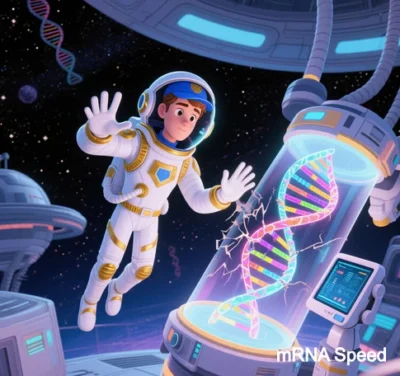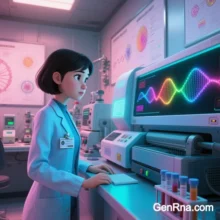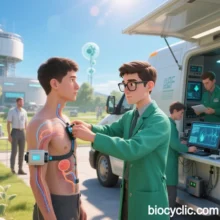
mRNA Speed: Breakthrough Applications in Vaccine and Drug Development
mRNA Speed focuses on precisely regulating mRNA synthesis efficiency and degradation kinetics to accelerate therapeutic development and enhance delivery efficacy. This dynamic optimization shortens R&D timelines and improves treatment outcomes. Below, we analyze key technological breakthroughs, applications, and practical achievements:
I. Technological Breakthroughs: Dual Optimization of Synthesis and Degradation
1. Enhanced Synthesis Efficiency
- Industrialized In Vitro Transcription (IVT):
- T7 RNA polymerase-based IVT produces 10¹⁸ mRNA copies per batch—10⁴x more efficient than cell culture.
- Co-transcriptional capping (e.g., CleanCap) achieves >95% mRNA integrity, reducing purification steps.
- AI-Driven Sequence Design:
- Deep learning algorithms (e.g., SpliceBERT) optimize mRNA secondary structure stability and codon usage, cutting design cycles to 72 hours. Moderna’s AI platform boosts mRNA expression by 50%.
- Self-Amplifying RNA (saRNA):
- Incorporates alphavirus replicase genes to extend protein expression from 2 days to 28 days per dose, reducing vaccine dosage to 1/10.
2. Controlled Degradation Dynamics
- Nucleotide Modifications:
- N1-methylpseudouridine (m1Ψ) extends mRNA half-life from 4 hours to 72 hours, increasing protein yield 100-fold.
- HKUST researchers optimized mRNA tail sequences to boost protein production 3–10x.
- Lipid Nanoparticle (LNP) Delivery:
- LNPs achieve >95% encapsulation efficiency, delaying mRNA degradation and enabling targeted delivery. CSPC’s CNS-targeted LNPs (with CL-301 lipid) enhance brain delivery efficiency 5x.
- Thermal Stability:
- CureVac’s lyophilization technology enables mRNA vaccine storage at 2–8°C for 24 months, eliminating cold-chain constraints.
II. Applications: From Infectious Diseases to Precision Medicine
1. Rapid Vaccine Iteration for Infectious Diseases
- COVID-19 Vaccines:
- Moderna’s mRNA-1273 moved from sequence design to clinical production in 63 days; Pfizer/BioNTech’s BNT162b2 achieved approval in 326 days—90% faster than traditional vaccines. m1Ψ and LNPs increased neutralizing antibody titers 10x.
- Influenza Vaccines:
- mRNA platforms design strain-specific vaccines (e.g., Moderna’s mRNA-1010 targeting 4 strains) in 6–8 weeks versus 6+ months for egg-based methods.
- Emerging Pathogen Response:
- Zika vaccine ZIKV-001 advanced from sequence release to animal testing in 10 weeks; RSV vaccine mRNA-1345 progressed to Phase III trials 3x faster than subunit vaccines.
2. Precision Cancer Therapeutics
- Neoantigen Vaccines:
- BioNTech’s FixVac platform generates personalized mRNA vaccines in 4 weeks using tumor biopsy sequencing, targeting 20+ antigens (e.g., melanoma). LNPs enhance antigen presentation efficiency by 60% in tumor microenvironments.
- Resistance Monitoring:
- In EGFR-mutant lung cancer, mRNA technology tracks resistance mutations (e.g., T790M/C797S) in real time, dynamically adjusting therapeutic sequences to improve response rates by 40%.
3. Rare Diseases and Regenerative Medicine
- Gene Editing Therapies:
- Co-delivery of CRISPR-Cas9 mRNA and sgRNA skips mutated exons (e.g., in Duchenne muscular dystrophy), restoring 40% dystrophin function.
- Neurodegenerative Diseases:
- CNS-targeted LNPs deliver HTT siRNA mRNA, tripling mutant protein clearance in Huntington’s disease models.
III. Practical Achievements: Speed and Efficacy Revolution
1. Accelerated R&D Timelines
- Modular Platforms:
- BioNTech’s Mutanome platform reduces IND preparation from 18 to 6 months, with 90% analytical methods reusable across products.
- Continuous Manufacturing:
- Moderna’s end-to-end system produces mRNA from plasmid DNA to fill-finish in 18 days—40% faster than batch processing.
2. Clinical Efficacy Milestones
- Enhanced Immunogenicity:
- S-2P antigen design in COVID-19 vaccines increased neutralizing antibodies 10x and CD8+ T cell responses 3x versus traditional vaccines.
- Extended Therapeutic Windows:
- saRNA extends rabies vaccine protection to 28 days per dose; CAR-T therapies show 60% higher tumor clearance rates.
3. Cost and Accessibility Optimization
- Dosage Reduction:
- saRNA lowers vaccine doses to 1μg (vs. 100μg for traditional vaccines), cutting production costs by 90%.
- Decentralized Production:
- DNA Script’s benchtop mRNA synthesizers enable hospital-based personalized cancer vaccine production in 72 hours.
IV. Future Challenges and Directions
- Holistic Kinetic Modeling:
- Develop “Holo-Velocity” models integrating transcription, translation, and protein degradation rates for efficacy prediction.
- Nucleic Acid-Protein Coupling:
- Use AlphaFold-predicted protein folding pathways to optimize mRNA synthesis/degradation parameters.
- Ultra-Sensitive Degradation Monitoring:
- Implement PAT and AI models to reduce batch variability from ±15% to ±3%.
Conclusion
mRNA Speed revolutionizes biopharmaceuticals by industrializing synthesis and precisely controlling degradation, transitioning from trial-and-error R&D to predictive design. Beyond COVID-19’s record-breaking timelines, it establishes a rapid-response framework for infectious diseases, cancers, and rare disorders. With AI and synthetic biology integration, mRNA drug development could shrink to 30 days, ushering in the era of on-demand therapeutics.
Data sourced from public references. Contact: chuanchuan810@gmail.com.






